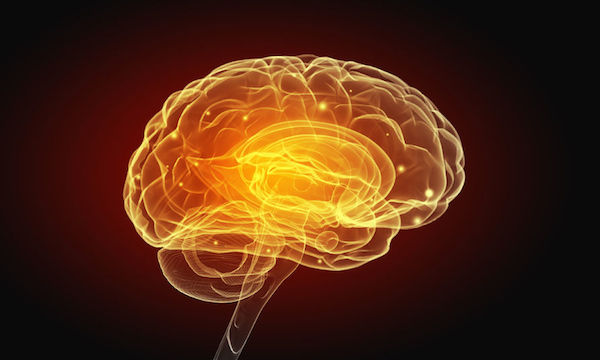
Brain Regeneration: Can Infrared Light Reverse Parkinson’s and Alzheimer’s?
Posted on: Wednesday, December 21st 2022 at 5:15 pm
Written by: Ali Le Vere, B.S., B.S. - Senior Researcher-GreenMedInfo
Alzheimer's disease and Parkinson's disease are the most common neurodegenerative disorders. The former is a type of dementia that occurs secondary to the accumulation of abnormal protein deposits in the brain, including β-amyloid plaques and intraneuronal neurofibrillary tangles made of tau protein (1). Upon neuroimaging studies, gross cerebral cortical atrophy is found, meaning that the part of the brain responsible for executive functions such as learning, memory, language, decision-making, and problem-solving progressively degenerates (1). In addition, gliosis, or brain inflammation, is a hallmark characteristic of Alzheimer's (1).
One hypothesis that is championed proposes that Alzheimer's occurs due to self-propagating, prion-like protein assemblies, which interfere with the function of nerve cells (2). An alternate theory is that these so-called proteinopathies occur secondary to a microvascular hemorrhage or brain bleed (3). The brain bleed is believed to be the result of age-induced degradation of cerebral capillaries, which creates neuron-killing protein plaques and tangles (3).
Dysfunction of mitochondria, the energy-generating powerhouses of the cell, is also implicated in Alzheimer's, as reduced efficacy of these organelles creates oxidative stress-inducing reactive oxygen species, or free radicals, which lead to neuronal cell death (4). Whatever the cause, extensive death of brain cells occurs, which explains the cognitive deficits that occur with Alzheimer's disease, in addition to symptoms such as impaired judgment, confusion, agitation, linguistic abnormalities, social withdrawal, and even hallucinations (1).
Parkinson's disease, on the other hand, is characterized by progressive death of dopamine-producing neurons in a region of the brainstem called the substantial nigra, but it can extend to other brain areas such as the locus coeruleus, olfactory bulb, dorsal motor nucleus of the vagal nerve, and even the cortex in late stages (5). As a result, the primary manifestation is that dopamine deficiency appears in the basal ganglia, a set of nuclei embedded deep in the brain hemispheres that is responsible for motor control (6). This leads to the cardinal manifestation of Parkinson's, namely, a movement disorder that includes bradykinesia or slow movement, loss of voluntary movement, muscular rigidity, and resting tremor (7).
Not unlike what happens in Alzheimer's, accumulation of abnormal intracellular protein aggregates known as Lewy bodies, composed of a protein called α-synuclein, is thought to be central to the pathogenesis of Parkinson's disease (8). Like Alzheimer's, mitochondrial dysfunction induced by genetic mutations, toxic agents, or damage to blood vessels is also considered to contribute to neuron cell death in Parkinson's (9). Toxin exposure is especially implicated, as animal studies hint that development of Parkinson's disease may occur as a byproduct of exposure to neurotoxins such as rotenone or paraquat (10). Impaired blood brain barrier function and damage to the endothelial cells of the vascular system, which line the interior surface of blood vessels, are also thought to play a role in Parkinson's (10).
Overturning Old Notions of Neuroscience
The central dogma of neuroscience conceived of the central nervous system tissue as "perennial" after the doctrines of Giulio Bizzozero, the most prominent Italian histologist, who decreed that the lifelong cells of the nervous system were devoid of replicative potential (11). In other words, the perennial nature ascribed to the nerve cells of the brain and spinal cord meant that nerve cells were believed to be incapable of undergoing proliferation, or cell division, in the postnatal brain (11). While the early stage of in utero prenatal development known as embryogenesis permits massive neurogenesis, or the ability to create new nerve cells, the scientific consensus up until the end of the twentieth century held that neurogenesis was arrested after birth in mammals.
Santiago Ramon y Cajal, who led the charge in the neuroscience discipline in the later half of the nineteenth century onward and won a Nobel Prize for Medicine and Physiology, in fact stated that: "Once development was ended, the fonts of growth and regeneration of the axons and dendrites dried up irrevocably. In adult centers, the nerve paths are something fixed and immutable: everything may die, nothing may be regenerated" (11). Acknowledgment of the mere possibility of adult neurogenesis was hampered by the fact that scientists lacked the visualization techniques to detect neural stem cells, the precursors to new neurons and means by which neurogenesis occurs, and also did not have access to the molecular markers and microscopy required to observe cells in different cycle phases.
This view of nervous tissue as perennial was also reinforced by clinical observations that patients with chronic neurodegeneration, traumatic brain lesions, and cerebrovascular diseases do not experience functional recovery (11). Prevailing theories posited that adult neurogenesis was an evolutionary unlikelihood, since it would interfere with pre-existing neuronal connections and the fine-tuned electrochemical communication in the nervous system, as well as disrupt memory recall, which was believed to occur via stable neuronal circuits created and encoded during learning (11).
That brain cells are finite, and incapable of regeneration, painted a portrait of doom and gloom and inexorable debilitation for patients suffering from devastating neurodegenerative conditions. However, relatively recent discoveries have overturned these antiquated conceptions by revealing that the brain is plastic, or pliable, and that even neurons in adult higher vertebrates are capable of neurogenesis.
Scientists Discover Neural Regeneration is Possible
In the 1960s, these postulates of the old neurobiology were disproven when Joseph Altman and colleagues performed an experiment where radioactively labelled thymidine, one of the nucleotide base pairs that makes up DNA, was incorporated into a brain area called the dentate gyrus of the hippocampus and integrated into the genetic material of what was later confirmed via electron microscopy to be dividing neurons (12, 13). In essence, this illustrated that neurons were undergoing mitosis, a process of cell division where genetically identical daughter cells are created, and showed that adult neurogenesis is possible.
Another nail in the coffin of this antiquated perception of the nervous system was that neural stem cells, the multipotent, self-renewing progenitors from which new neurons arise, were found in the brains of adult mammals, and discovered to undergo expansion in their populations when prompted by signaling molecules called growth factors and morphogens (11). The multiplication and differentiation of neural stem cells, which are residents of the central nervous system, is essential for neurogenesis (14). Neural stem cells are capable of generating all of the cell types of the nervous system, including astrocytes, glial cells, and what are called oligodendrocytes in the central nervous system and Schwann cells in the peripheral nervous system (11). Researchers Colucci-D'Amato and Bonita in fact state that, "To date neural stem cells have been isolated from nearly all areas of the embryonic brain and in a growing list of adult mammalian brain areas, including cerebellum and cortex" (11, p. 268).
Other advances, such as confocal microscopy and the identification of cellular markers which allowed the phenotype of cells to be characterized all culminated in the realization that neurogenesis occurs continuously in some brain area, such as the hippocampus and subventricolar zone (SVZ), the former of which is responsible for the formation and consolidation of memories (11). To date, neurogenesis has been shown to be influenced by various chemical, pharmacological, and environmental stimuli. For instance, work by researcher Fernando Nottebohm demonstrated the spontaneous replacement of neurons in the adult avian brain (15). In song birds such as canaries, which experience seasonal modification in their songs, new neurons are recruited into their neuronal circuitry in a way that may be dependent upon social and reproductive interactions, territorial defense, migratory patterns and food caching (15).
This all should serve as a beacon of hope for patients experiencing the ravages of neurodegenerative disease, as it may mean that epigenetics, or the way gene expression changes based on lifestyle factors, may lend itself to neurogenesis and the reversal of these scourges of mankind. For example, researchers state that an enriched environment, learning, exercise, exposure to different odorant molecules, and drugs such as antidepressants, steroids, and alcohol can all favorably or unfavorably impact neurogenesis (11). These newfound revelations are being used in fact as an impetus to find cures for a laundry list of neurodegenerative diseases (11).
Novel Therapy Shown to Grow New Nerve Cells
Despite this research, the prevailing view of neurodegenerative diseases such as Alzheimer's and Parkinson's is that their underlying pathophysiology, a relentless progression of neuronal death, remains irreversible (10). Thus far, then, approaches have aimed to slow or stop neuronal cell death or to develop disease-modifying treatments that could stabilize the rate of neurodegeneration (10). One non-pharmacological therapy that may be able to actually regenerate brain cells, however, is light in the near infrared range, also known as low-level laser or light emitting diode (LED) therapy that utilizes wavelengths in the red to infrared spectrum.
Near infrared light therapy has the potential to "mitigate ubiquitous processes relating to cell damage and death," and may have applications in conditions that "converge on common pathways of inflammation and oxidative stress" (10). This is demonstrated by the widespread efficacy of near infrared light therapy in improving conditions including traumatic brain injury, ischemic stroke, major depression, and age-related macular degeneration (10). In traumatic brain injury, for example, treatment with near infrared light improves social, interpersonal, and occupational functions, reduces symptoms of post-traumatic stress disorder (PTSD), and is helpful for sleep (16).
Because near infrared light treatment improves cognitive and emotional dimensions (17) and enhances short-term memory and measures of sustained attention (18), researchers have long suspected its potential for neuropsychological disorders. In a revolutionary publication, scientists propose that infrared light is superior to pharmacological standard of care for these debilitating conditions given its neuron-saving abilities (10).
For instance, in mouse models of traumatic brain injury, near infrared light increases levels of brain-derived neurotrophic factor (BDNF), a protein which helps dying nerve cells survive (19). In addition, infrared light both improves neurological performance and increases the numbers of neuroprogenitor cells, the precursors to new neurons, in areas of the brain such as the dentate gyrus of the hippocampus and the sub ventricular zone (20).
Near Infrared Light Therapy in Alzheimer's and Parkinson's
Although human trials have not been yet conducted in Alzheimer's disease, mouse studies show that near infrared treatment reduces its characteristic proteinopathies, decreasing brain levels of β-amyloid plaques and neurofibrillary tangles of tau proteins, while also ameliorating cognitive deficits (10). Cellular energy production, as indicated by levels of ATP, were increased in these studies alongside bolstered mitochondrial function and (10). In transgenic mouse models of Alzheimer's, application of non-thermal near infrared light reversed significant deficits in working memory and significantly improved cognitive performance (21).
In animal models of Parkinson's, near infrared treatment has been shown to rescue dopaminergic neurons, the subset that degenerate in this condition, from death (10). In addition, near infrared light treatment corrects the abnormal firing activity of neurons in deep subthalamic brain regions that occurs in parkinsonian conditions (22). Various animal models of Parkinson's disease shown improved motor control and locomotor activity, as measured by both mobility and velocity, after near infrared is applied (10).
In a macaque monkey model of Parkinson's, an optical fiber device that administered near infrared to the midbrain largely prevented the development of clinical signs of Parkinson's when the animals were injected with a chemical known to induce this disorder (23). It also preserved a greater number of dopaminergic nigral cells compared to the monkeys that had not received infrared treatment (23). Limited case reports in humans have shown that near infrared administered through an intranasal apparatus improves symptoms in the majority of Parkinson's patients, and that its application to the back of the head and upper neck reduced signs of Parkinson's in one patient (10). Other reports indicate that gait, speech, cognitive function, and freezing episodes were improved in late-stage Parkinson's patients who undertook this therapy (24), but the study was low-quality (10).
Mechanism of Action: How Near Infrared Promotes Neurogenesis
The ways in which near infrared promotes neurogenesis are multi-fold. There is evidence that near infrared light exerts a hormetic effect, acting as an adaptive or positive stressor. Another example of a hormetic effect is that exhibited by phytonutrients in fruits and vegetables, which act as antioxidants by paradoxically stimulating oxidative damage via a pro-oxidant mechanism. This in turn up-regulates our endogenous antioxidant defense system. Similarly, near infrared light activates cellular stress response systems by targeting a key enzyme in the electron transport chain which is responsible for mitochondrial-based energy production called cytochrome c oxidase, an enzyme that is fundamental to the cellular bioenergetics of nerve cells (25).
By accepting light in the near infrared range of the electromagnetic spectrum, this enzyme induces a change in the electrochemical potential of the mitochondrial membrane, jump-starting production of the cellular energy currency called adenosine triphosphate (ATP) and causing a mild burst in the synthesis of reactive oxygen species (ROS) (10). As a result, downstream signaling pathways are triggered which induce reparative and neuroprotective mechanisms, including neurogenesis, the creation of new synapses, and brain-based antioxidant and metabolic effects (25).
Restoration of mitochondrial function in the endothelial cells lining cerebral blood vessels may also help neurons survive by repairing the blood-brain barrier and vascular network which is compromised in neurogenerative conditions (10). Impressively, "This modulation of multiple molecular systems appears capable of both conditioning neurons to resist future damage and accelerating repair of neurons damaged by a previous or continuing insult" (10).
On the other hand, the application of near infrared light has been shown to elicit systemic effects, possibly via circulating molecular factors (10). In other words, light in the near infrared spectrum applied to a local area elicits benefits in distal tissues remote from the initial site, perhaps by stimulating immune cells that have a neuroprotective role (10). Another way in which near infrared light activates global effects in the body is by up-regulating the production of signaling molecules known as anti-inflammatory cytokines, while down-regulating pro-inflammatory cytokines (26).
Near infrared also mobilizes tissue repair processes by improving the migration of white blood cells to wounds, increasing neovascularization, or the formation of new blood vessels, and facilitating formation of collagen (27). There is also evidence that near-infrared light exposure causes stem cells from the bone marrow to navigate to the site of damage and to release so-called trophic factors such as BDNF, which enhances nerve cell function and survival (28). Lastly, a system of communication between the mitochondria in the brain and the mitochondria in the tissues may be at play, so that application of near infrared light at a point in the body far from the brain can lead to neural regeneration (10).
Practical Application of Near Infrared Light Therapy
The key to mitigating the burden of chronic illness lies in physiological regeneration, which is emerging as a physiological inevitability, even in regions of the body where it was previously not thought possible. The ability to regenerate, secondary to normal biological processes of cellular erosion and decay, is programmed into our body in order for us to regain homeostasis.
So-called "photobiomodulation," which includes near infrared light therapy, has limitless possible applications, and has even been shown to improve animal models of wound healing, heart attack, spinal cord injury, stroke, arthritis, familial amylotropic lateral sclerosis (FALS), diabetic ulcers, carpal tunnel syndrome, major depression, generalized anxiety disorder, frontotemporal dementia (29) and traumatic brain injury (27).
The biggest obstacle with infrared light therapy in neurodegenerative disease is targeting the zone of pathology, "when there are many intervening body tissues, namely skin, thick cranium, and meninges, and brain parenchyma," since there is considerable dissipation of the signal across each millimeter of brain tissue (10). This is less problematic in Alzheimer's, where the target regions are more superficial structures, but less easily rectified in the case of Parkinson's, where there is significant distance from cranium to the brainstem where neurodegeneration takes place (10).
With Alzheimer's, optimal delivery would be a near infrared light-emitting helmet worn over the entire cranium (10). Parkinson's patients can achieve symptomatic relief when near infrared is applied in this fashion, as this would influence the abnormal neural circuitry in the cortex. However, to circumvent the problem of the sheer distance to the region of pathology in the brainstem, researchers propose that the minimally invasive surgical implantation of an optical fiber device near the brain parenchyma would be ideal, which would deliver therapeutic levels of near infrared (10). Until these options are commercially available, photobiomodulation devices or near infrared saunas may be a viable option, although human studies have not proved their efficacy.
Given its large margin of safety and lack of adverse effects, near infrared light therapy should be offered as an option for patients suffering from a myriad of chronic conditions, but is especially promising for neurodegenerative diseases including Alzheimer's and Parkinson's and may even have future use in multiple sclerosis. Near infrared therapy is superior to the mainstay drug treatments for these diseases since pre-clinical studies have demonstrated proof-of-concept that near infrared either arrests or slows the underlying pathology of these disease processes, and leads to the birth of new neurons, rather than merely mitigating symptoms (10).
------------------------------------------------------------------------------------------------
For healthcare professionals wanting to learn more about dementia and treatments consider these online continuing education courses:
- Diagnosing Dementia
- Introduction to Dementia
- Treatment of Dementia
- Problem Solving Strategies in Dementia Care
- Massage and Compassionate Touch® in Dementia Care
These courses may also be purchased in a cost saving package: Dementia Continuing Education Package
Pedagogy's courses are available for purchase by the individual or facility. For individuals, register with us to create your username and password, click on the course title of interest and then click the Buy Now button. For a complete listing of all our online continuing education courses, including the largest selection of infusion continuing education courses offered online, click here!

